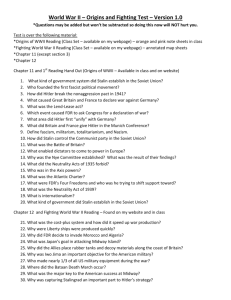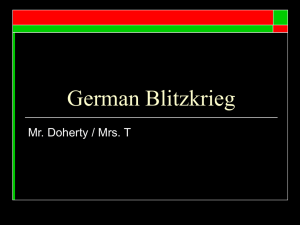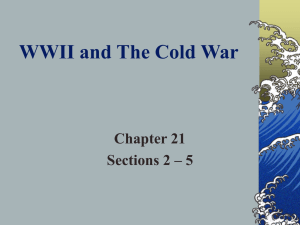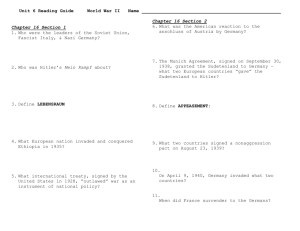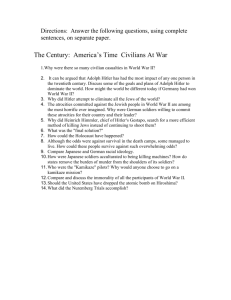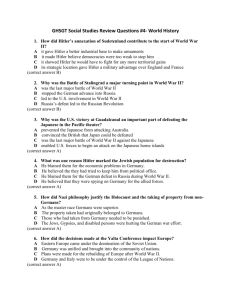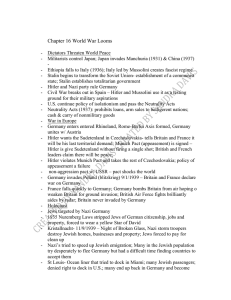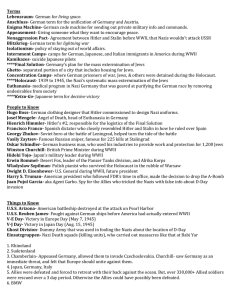Ch. 24 & 25 Study Guides
advertisement
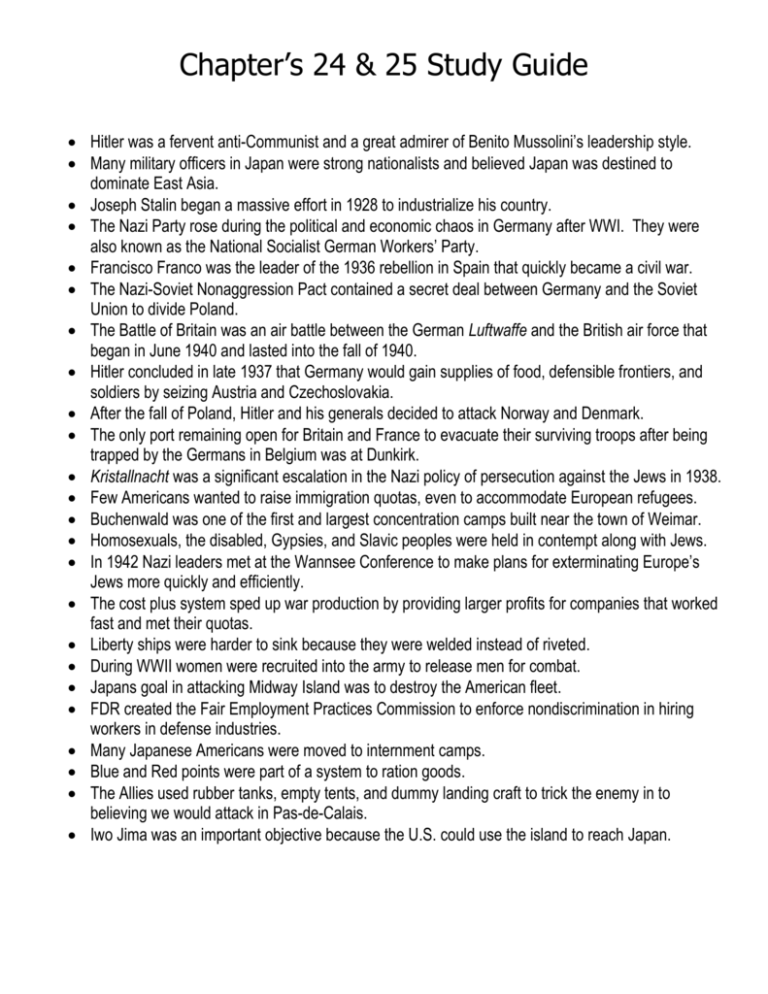
Chapter’s 24 & 25 Study Guide Hitler was a fervent anti-Communist and a great admirer of Benito Mussolini’s leadership style. Many military officers in Japan were strong nationalists and believed Japan was destined to dominate East Asia. Joseph Stalin began a massive effort in 1928 to industrialize his country. The Nazi Party rose during the political and economic chaos in Germany after WWI. They were also known as the National Socialist German Workers’ Party. Francisco Franco was the leader of the 1936 rebellion in Spain that quickly became a civil war. The Nazi-Soviet Nonaggression Pact contained a secret deal between Germany and the Soviet Union to divide Poland. The Battle of Britain was an air battle between the German Luftwaffe and the British air force that began in June 1940 and lasted into the fall of 1940. Hitler concluded in late 1937 that Germany would gain supplies of food, defensible frontiers, and soldiers by seizing Austria and Czechoslovakia. After the fall of Poland, Hitler and his generals decided to attack Norway and Denmark. The only port remaining open for Britain and France to evacuate their surviving troops after being trapped by the Germans in Belgium was at Dunkirk. Kristallnacht was a significant escalation in the Nazi policy of persecution against the Jews in 1938. Few Americans wanted to raise immigration quotas, even to accommodate European refugees. Buchenwald was one of the first and largest concentration camps built near the town of Weimar. Homosexuals, the disabled, Gypsies, and Slavic peoples were held in contempt along with Jews. In 1942 Nazi leaders met at the Wannsee Conference to make plans for exterminating Europe’s Jews more quickly and efficiently. The cost plus system sped up war production by providing larger profits for companies that worked fast and met their quotas. Liberty ships were harder to sink because they were welded instead of riveted. During WWII women were recruited into the army to release men for combat. Japans goal in attacking Midway Island was to destroy the American fleet. FDR created the Fair Employment Practices Commission to enforce nondiscrimination in hiring workers in defense industries. Many Japanese Americans were moved to internment camps. Blue and Red points were part of a system to ration goods. The Allies used rubber tanks, empty tents, and dummy landing craft to trick the enemy in to believing we would attack in Pas-de-Calais. Iwo Jima was an important objective because the U.S. could use the island to reach Japan. Chapter’s 24 & 25 Study Guide The U.S. used napalm to cause massive fires in Japan. Over 1/3 of all military equipment was made by the automobile industry. The double “V” campaign meant victory over Hitler’s racism abroad and racism at home. The Bataan Death March occurred in the Philippines. The capture of Stalingrad was key to the success of Hitler’s strategy to destroy the Soviet economy. Migrant farm workers became an important part of the Southwest’s agricultural system as a result of the Bracero Program. The case Korematsu v. the U.S the Supreme Court ruled that relocation of Japanese Americans was constitutional because it was based on military urgency. As a result of the Allied attack on Sicily the Italian king arrested Mussolini. The U.S. Marines had severe casualties at Tarawa in part because the shallow reef prevented many landing craft from reaching shore. WWII put an end to the Great Depression. The Allies massive bombing campaign against Germany destroyed so many aircraft factories the Allies gained control of the air. Adolf Hitler committed suicide. During WWII US workers were more productive than German or Japanese workers. After WWII Truman fully integrated the military. FDR said he would lift the oil embargo if Japan withdrew from Indochina and made peace with China. Hitler accepted the French surrender in the same rail car the Germans had surrendered in at the end of WWI. To get around the Maginot Line the Germans would have to invade the Netherlands, Belgium, and Luxemburg. At the Munich Conference Britain and France agreed to Hitler’s demands and informed Czechoslovakia’s leaders they must give up the Sudetenland. The US did not agree to defend Poland in March of 1939. After France surrendered both Marsha Philippe Petain and Adolf Hitler were concerned about the bravery of the British people and their leader Winston Churchill. Joseph Stalin did not ask for Americans to help defend the eastern front of the Soviet Union. During the war crimes trials the Japanese emperor was not sentenced to death. The U.S. did not suffer as many casualties as did its allies. FDR did not immediately block the sale of airplane fuel and scrap iron to France after Congress passed the Export Control Act. FDR’s destroyers for bases deal did not lead to the founding the America First Committee.




